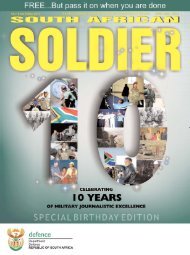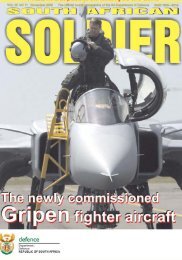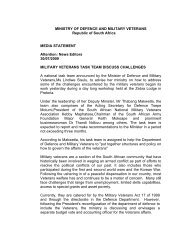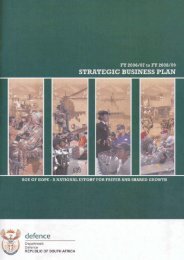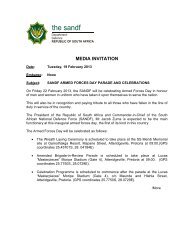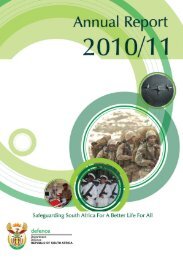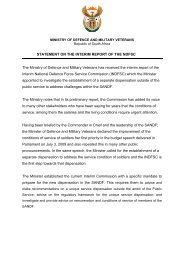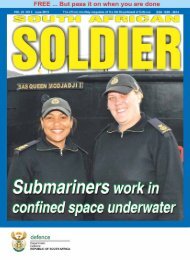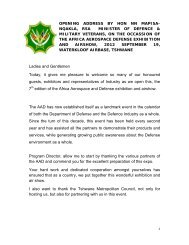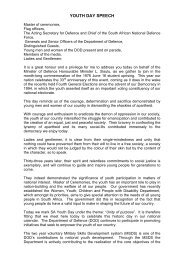Chapter 2 - P rogramme 1 - Department of Defence
Chapter 2 - P rogramme 1 - Department of Defence
Chapter 2 - P rogramme 1 - Department of Defence
Create successful ePaper yourself
Turn your PDF publications into a flip-book with our unique Google optimized e-Paper software.
Overview<br />
| <strong>Department</strong> <strong>of</strong> <strong>Defence</strong> |<br />
CHAPTER 4<br />
P<strong>rogramme</strong> 2: Landward <strong>Defence</strong><br />
The South African Army made a concerted effort<br />
at all levels to achieve its objectives to ensure that<br />
the SANDF honours its ordered commitments and<br />
thereby supports Government initiatives to promote<br />
peace, security and stability on our Continent and<br />
support the people <strong>of</strong> our country. Key processes<br />
to ensure the achievement <strong>of</strong> force preparation<br />
and readiness targets were instituted and refined.<br />
Audits by the Inspector-General (IG) Army, IG<br />
DOD and Auditor-General assisted in the process<br />
<strong>of</strong> continuously improving performance through<br />
accurate reporting and accountability. Performance<br />
management was integrated with other processes,<br />
especially the Strategic Management Process (SMP).<br />
Of note is the corporate SA Army Performance<br />
Review System, which enables performance<br />
information to be confirmed and progress to be<br />
tracked, as well as decisions to improve organisational<br />
performance and critical underperformance to be<br />
taken by the Army Council. Consequently, the past<br />
year saw the SA Army not only meeting the required<br />
force levels, but also instituting key management<br />
processes that enhanced its governance and controls.<br />
The achievements and challenges for the past year<br />
are highlighted in this report.<br />
The SA Army remains the largest contributor <strong>of</strong><br />
forces to the various missions by the SANDF. In<br />
this regard, forces were provided for nine external<br />
operations, while forces were simultaneously<br />
provided for three internal operations. The external<br />
operations in Burundi, the Democratic Republic<br />
<strong>of</strong> the Congo (DRC), Sudan, Eritrea, Uganda and<br />
Mozambique were supported by approximately<br />
4 200 Army members within several rotations.<br />
Altogether, 24 Regular and six Reserve companies<br />
(approximately 3 000 members) were deployed in<br />
internal operations related to rural safeguarding<br />
and borderline control. In addition, 62 Regular<br />
and Reserve platoons (1 909 members) provided<br />
support to Operation BATA, the SANDF operation<br />
in support <strong>of</strong> the <strong>Department</strong> <strong>of</strong> Health during the<br />
public sector strikes.<br />
Apart from deployment in peace support missions,<br />
contributions were also made to the development and<br />
training <strong>of</strong> foreign forces. Arising from the bilateral<br />
discussions between the DRC and RSA and requests<br />
made to the SANDF, intensive training assistance<br />
was provided by 73 SA Army members to the DRC<br />
forces (FARDC). Similar assistance was provided<br />
to the Central African Republic by 14 members.<br />
Small SA Army teams participated in four exercises<br />
in support <strong>of</strong> foreign force training. The increased<br />
bilateral and multilateral interaction has not only<br />
strengthened relations between the African armies,<br />
but has also set a firm basis for interoperability and<br />
harmonisation towards the African Standby Force,<br />
the SADC Brigade.<br />
Force preparation <strong>of</strong> landward capabilities remains<br />
the core business <strong>of</strong> the SA Army. Important<br />
exercises and tests were conducted during the year.<br />
The SA Army Air <strong>Defence</strong> Artillery Capability<br />
successfully fired the first Starstreak missile on<br />
South African soil at Overberg Test Range (OTR).<br />
The SA Army Armour capability has successfully<br />
commissioned and put into active service its new<br />
armour equipment, the 12 x Mk2 Main Battle<br />
Tanks and 13 x ZT3 missile systems. During<br />
Exercise SEBOKA the Rooivalk Attack Helicopter,<br />
in full observation <strong>of</strong> its new doctrine, fired live<br />
ammunition and manoeuvred with the ground forces<br />
for the first time and verifying the interoperability.<br />
Seven mortar simulators have been installed at<br />
various Regular and Reserve Infantry units. This has<br />
enhanced training and will bring about savings on<br />
mortar ammunition.<br />
The January 2007 Military Skills Development System<br />
(MSDS) members successfully completed their<br />
training, which culminated in integrated training at<br />
the Combat Training Centre and De Brug Training<br />
Areas through Exercise SEBOKA and Exercise<br />
YOUNG EAGLE, respectively. It was during<br />
Exercise SEBOKA that the tragic training accident<br />
occurred, resulting in the loss <strong>of</strong> nine Air <strong>Defence</strong><br />
Artillery (ADA) gunners and injury to 15. High-level<br />
investigations into the accident were concluded and<br />
rectifications will be instituted on conclusion <strong>of</strong> the<br />
findings. Regarding the January 2008 MSDS intake,<br />
1 600 members are currently undergoing training in<br />
SA Army Training Centres/Centres <strong>of</strong> Excellence<br />
(COE). The targets <strong>of</strong> 24% white candidates and<br />
103 Annual Report FY 2007 - 2008<br />
| <strong>Chapter</strong> 4 - P<strong>rogramme</strong> 2: Landward <strong>Defence</strong> |



